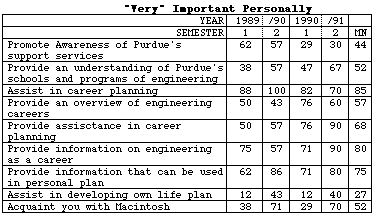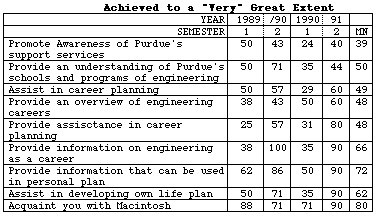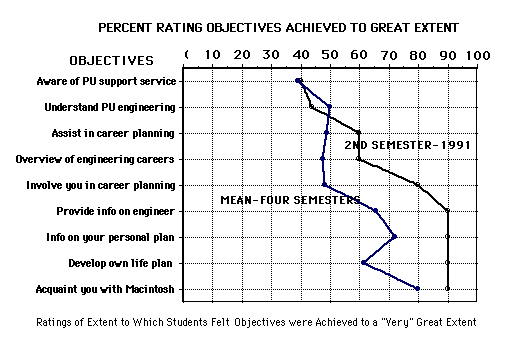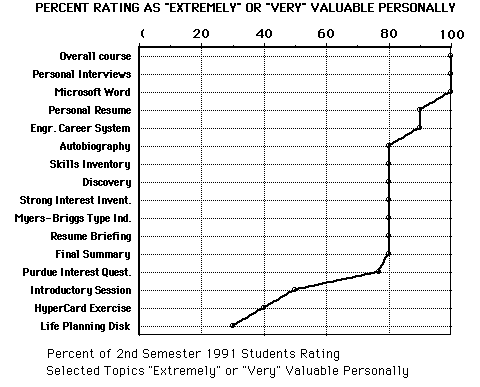hopper, lebold & feghali, 1991
Hopper, M.E., LeBold, W.K., Feghali, A.A. (1991).
A Hypermedia-Based Problem-Solving Approach to Engineering, Learning, Working,
and Playing. In 1991 Frontiers in Education Proceedings, p. 73-78.
There is a need in engineering education to prepare students for lifelong career planning.
Emerging computer technology may be able to play a role in addressing this need. To explore
this possibility, we have been offering an experimental course in Engineering Career Planning
for beginning engineering students. Students use computers to do assignments and store
personalized guidance data. In addition, we developed a hyper-media program called the
Engineering Career System to provide useful information during the planning process.
Evaluations of the course have been very positive, and show the computer materials have
played a successful supporting role in the course.
This project was supported in part by Purdue's Dean's Club "Creative Undergraduate Instruction Project",
the Purdue Engineering Student Council and the Purdue Department of Engineering.
There is a major need in engineering education to improve, extend and personalize the academic and
career development of students and graduates. This development is especially critical in the early
formative pre-college and undergraduate years and has broader implications that extend to the graduate,
professional, and post-college years as well. Various studies indicate significant concern and
considerable dissatisfaction with academic advising and career guidance. The Study Group Report
on Excellence in Undergraduate Education made the following recommendations:
All colleges should offer a systematic program of guidance and advisement that involves
students from matriculation through grad- uation. Student affairs personnel, peer counselors,
faculty, and administrators should all participate in this system on a continuing basis.
We have previously recommended a strong advising system for first-year students. But in this
recommendation we are confronting a broader problem: advisement is one of the weakest links in
the education of college students (TSG, 1984)
The academic-career guidance problem is especially critical in undergraduate engineering education.
In a 1985 National Engineering Utilization Survey (Engineering Manpower Commission, 1986)
of engineering graduates, only 32% were "very satisfied' or "satisfied" with the quality of counseling,
28% with their academic counseling, and 23% with their career guidance. These three items were rated
the lowest of the 30 undergraduate factors evaluated.
The primary goal of the Purdue Engineering Career Development Project has been to address
this problem and improve the quality of undergraduate academic and career guidance in
undergraduate engineering education. One part of the project specifically explores the
feasibility of using emerging computer technologies to support the engineering career guidance process.
Now is an opportune time to take advantage of the high technology revolution in computer
assisted career guidance systems (Maze, 1987) and in career oriented
video technology systems. As a result, there has been a proliferation of increasingly high
quality educational and career development materials that are available to assist in supporting
the academic advising, career development, and life planning of engineering students.
These emerging computer and video technologies are ideally suited to improving the areas most
frequently identified by engineering students and graduates as the weakest links in their
undergraduate education: academic advising and career guidance.
The Purdue Engineering Career Development Project has set out to explore and establish the
appropriate role these technologies can play within the engineering career guidance process.
To provide an experimental context for more personalized academic and career development of
engineering students, and an environment to explore the feasibility of using emerging computer
technology to support the career guidance process, we created a pilot course, Engineering 195C -
Engineering Career Planning for beginning engineering students. For each regular semester
during the last two years, small groups (10-20) of first and second semester freshman engineering
students have met on a weekly basis to gain insight into a wide variety of resources designed to
help students begin their educational career and personal planning in engineering and/or related fields.
This pilot course offering has indicated that intensive two hour per week sessions offered for the first
eight weeks or last eight weeks of the semester are more effective than a one hour per week session distributed
during an entire semester.
Course activities have been organized around the following basic comprehensive decision making process:
- Define the problem
- Generate possible solutions.
- Evaluate each solution.
- Select the most plausible solution.
- Develop a plan of action.
- Implement the plan
- Evaluate its success.
Various introductory activities are designed to help the students define and understand the goal of
the life planning task before them. In order to provide an overview of this task, the students are
assigned the introductory chapters of the course text book, The Three Boxes of Life.
(4) During the first lab exercise, the students become familiar with
the Macintosh computers by completing an Apple Tour Program, and then receive a brief introduction
to the use of Microsoft Word. This lab exercise prepares the students to produce an autobiography
assignment designed to help them identify relevant facts, constraints and assumptions which they
will need to consider during their life planning process.
In order to engage in a broad, comprehensive career exploration process,
the class visits Purdue's Career Resource Center where they are introduced to the
American College Testing (ACT) software package called Discover, a general computer-based
career planning and information system that supports mature decision making.
While they are at the Career Resource Center, the students are briefed about methods
to gather information They also complete a series of three interest inventories including
the Strong Interest Inventory, The Purdue Interest Questionnaire, and a computer administered
version of the Myers-Briggs Type Indicator. The data collected during this session is placed
in a HyperCard stack to provide individual guidance through a personalized career and life
planning process allowing each student to develop an individualized database of aptitude and
interest information. This information is stored on floppy disks that can be updated and
personalized to meet their individual needs.
At this point in the course, students schedule a personal interview with the course instructor,
where they discuss their academic, career and leisure plans. These discussions include factors
like academic requirements for various programs and the relationship between the student's
personal qualities and their various career planning options. This interview helps many
students decide which field of engineering, or related discipline is most likely to fit
their life planning needs.
To provide a vehicle to help students in their final selection of an engineering career,
we have developed an exploratory interactive hypermedia program called the Engineering Career System
(Taghaboni, LeBold & Cheng, 1989). This HyperCard based project
actively engages students with career exploration by providing them with information about different
engineering disciplines, and experience with the specific nature of problem solving in those disciplines.
James Wilkinson, Director of the Harvard-Danforth Center for Teaching and Learning says that
"interactive media are 'good with students who come in having different levels of knowledge,
because it means you can give them a tool they can customize.' Software such as HyperCard,
which can highlight key words and enable program authors to create 'a series of footnotes
nested within each other,' allows the learners to 'look as far into the highlighted concepts as they want to,'
Wilkinson says. 'And it's infinitely patient--it doesn't laugh at you,' a fact helpful to shy or
inhibited students."(Lamber, 1990)
HyperCard files are designed around the basic metaphor of a "stack" of modifiable index
cards which can contain combinations of integrated text, sound, and pictures (including graphics)
with a minimum effort due to the HyperCard programming language called "HyperTalk". Students can
browse through the stacks easily by pressing appropriate buttons. There is also on-line instruction
which help students learn how to use the system. To eliminate confusion, the buttons are designed to
be self-explanatory. The advantage of using HyperCard is that each student is able to read and browse
through materials which are of interest to them. Because the software is extremely flexible,
there is no prescribed sequence which has to be followed. This flexibility is especially important
in encouraging academic and career exploration.
The current version of the Engineering Career System software contains information on the
engineering fields offered at Purdue University, with a long range goal of including virtually
all US engineering fields. The information provided for each field includes:
- an introduction
- career opportunities
- plans of study
- problem-solving
- organizations
- publications
(LeBold, Hopper & Feghali, 1991)
Toward the end of the course, a guest speaker from the University Placement Center visits the
class to start them on their way to carrying out their career plan. The students are told about
the interviewing process at Purdue, and are given a chance to create their resumé on an IBM PC
which they will be able to update and use when they enter the Purdue Placement process in their Junior year at Purdue.
In order to capture the results of the life planning process, the students are asked to write a brief
description of that plan to present during the last class session.
During the final class, students gather as a group to share an oral summary of their life plans and
their impressions of the course. They are reminded of the open invitation for continuing contact
with all the resource people they have met during the course.
A comprehensive 250 item survey is administered at the end of the course for summative evaluation.
Formative survey forms are used during the course to provide "on the spot" insight into the success
of special activities. Results have been most positive and have encouraged us to explore and further
develop the use of computer technology to support the engineering career planning process.
The summative course evaluation covered the areas of lectures, course assignments, lab exercises,
and the overall course. Table 1 below reveals the mean ratings of personal importance of
objectives in the course and the estimates of the extent to which the same objectives were achieved.

Table 1: "Trends in Mean Percent Ratings of Selected Topics of Students in
Experimental Career Development Course (1989-1991) Very" Important Personally

Table 1: "Trends in Mean Percent Ratings of Selected Topics of Students in
Experimental Career Development Course (1989-1991) Achieved to a "Very" Great Extent
Figure 1 describes the ratings to which the objectives were achieved.
The figure compare data over a four semester timeframe.

Figure 1: Ratings of Extent to Which Students Felt Objectives were Achieved to a "Very" Great Extent
Table 2 provides detailed data concerning the trends and mean percent ratings of selected
topics covered in the course.

Table 2: Trends and Mean Percent Ratings of Selected Topics by Students in the
Experimental Career Development Course (1989-1991) "Excellent" and "Good" Quality of Presentation

Table 2: Trends and Mean Percent Ratings of Selected Topics by Students in the
Experimental Career Development Course (1989-1991) "Extremely" or "Very Valuable" to Personal Learning
Figure 2 shows the students' ratings of the degree of the value they assigned
to different sections of the course. According to the figure, during the last administration
of the course, the overall course, the personal interviews and the Microsoft Word exercise received
the highest ratings of personal value to the student, followed closely by the Resume activity
and the Engineering Career System. The introductory session, the introduction to HyperCard exercise,
and the life planning disk received the lowest percentage regarding personal value to the students.

Figure 2: Percent of 2nd Semester 1991 Students Rating Selected Topics as
"Extremely" or "Very" Valuable Personally
The success of the course has been the personal opportunity that students have to share their concerns,
experiences, and aspirations with their peers, faculty, counselors, and the various resource persons
invited to participate in the course.
Our most immediate goal is to experiment with broader contexts to life planning for engineering students.
In order to do this, we have begun the process of freeing ourselves from the constraints of using Macintosh
as our only platform. HyperCard on the Mac II is not easily portable to other computer systems.
We are in the process of converting our stacks to database like HIFF files which can easily be stored
and transported across electronic networks. (HyperMedia Group, 1990)
This improved approach to structuring and storing hypermedia information will provide the means for
wider and more flexible dissemination of our growing database of engineering career information and data.
It will soon be possible to port the Engineering Career System, and adapt it to an IBM Personal Computer,
Next or Sun workstation.
An intermediate goal of our project will be expanding the Engineering Career System to be a Macintosh
based prototype complete hypermedia guidance support system. Future versions of the
Engineering Career System will utilize more extensive interactive video, sound, and graphics to
provide students with even more interesting in-depth educational, career, and personal development information.
The system will also expand to include computer-based learning environments, often called microworlds,
which will be used for introducing students to problem-solving as practised in each specific field of engineering.
(Lawler & Yazdani, 1987)
We eventually hope to provide tele-communications access to a national career guidance system with as rich
a hypermedia environment as possible in formats that are not hardware or software bound. Such a computer
guidance system will provide a easily accessible way to familiarizing students with both the value of
working in fields and the specific character of problem-solving in technical disciplines. It will help
engage students with possible careers as well as inform them about them.
This project addresses a critical area of undergraduate engineering education that has been consistently
criticized and undervalued - academic advising and career development. A comprehensive program to meet
career development needs within undergraduate engineering education is currently being conducted using
emerging computer technologies. Significant improvements in educational and career planning have been
observed, as measured by pre- and post-surveys. The implementation of computer supported guidance within
the context of an experimental engineering career planning course has helped provide more effective selection
of college majors and career fields, improved selection of courses, major fields, and more personalized
academic and career planning. The currently emerging interactive-video and cross-platform development
tools promise to provide even more potential for development of computer-based engineering career guidance
support systems.
1. (TSG, 1984) The Study Group (1984), Report on Excellence in Undergraduate Education, Chronicle of Higher Education.
2. (EMC, 1986) Engineering Manpower Commission (1986), Toward the More Effective Utilization of American Engineers, American Association of Engineering Societies, Washington, DC.
3. (Maze, 1987) Maze, Marilyn (Ed.) (1987), Special Issue on Computer and Career Counseling, Journal of Career Planning and Development, 3:23-74.
4. (Bolles, 1978) Bolles, R. (1978) Three boxes of life and how to get out of them. Ten Speed Press, Berkeley, California.
5. (Taghaboni, LeBold & Cheng, 1989) Taghaboni, F., LeBold, W.K.,and Cheng, H. (1989). Interactive Hyper-Engineering Career Planning, Proceedings of the 1989 ASEE-IEEE Frontiers In Education Conference, pp. 135-138.
6. (Lamber, 1990) Lamber, Craig (1990). The Electronic Tutor. Harvard magazine, 93, p 42-51.
7. (LeBold, Hopper & Feghali, 1991) LeBold, W.K., Hopper, M.E., Feghali, A.A. (1991). A Hypermedia solution to a Hyper Problem: Personalized Computer Engineering Career System. Proceedings of the 1991 ASEE-IEEE Conference, p. 482-488.
8. (Hypermedia Group, 1990) HyperMedia Group (1990). The HIFF Specification: Hypermedia Interchange File Format. Heizer Software, Pleasant Hill, CA.
9. (Lawler & Yazdani, 1987) Lawler, R. W. & Yazdani, M. (1987) Artificial Intelligence and Education. Ablex, Norwood, NJ.






